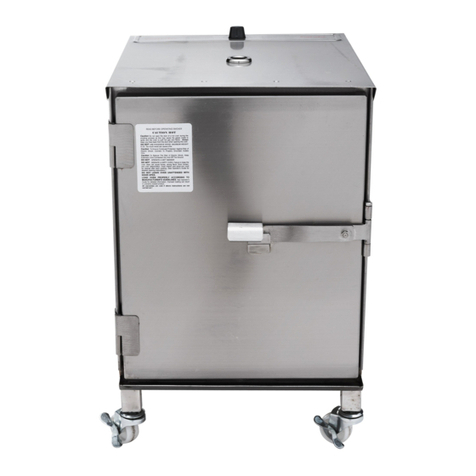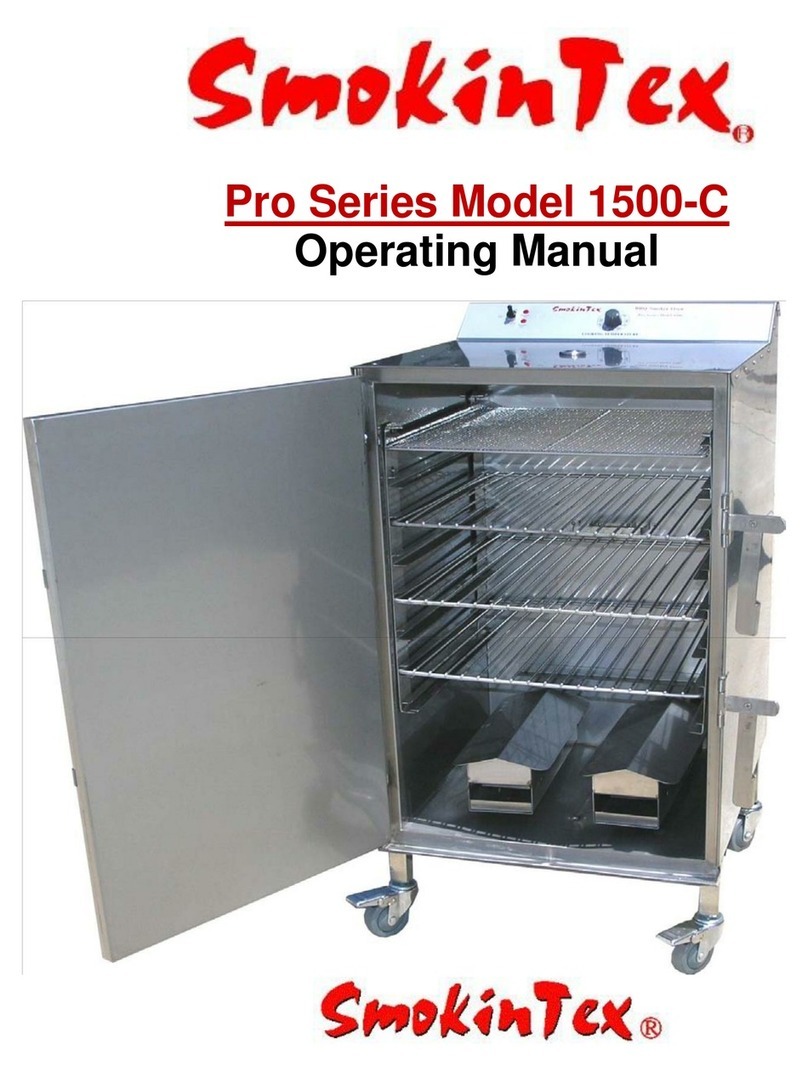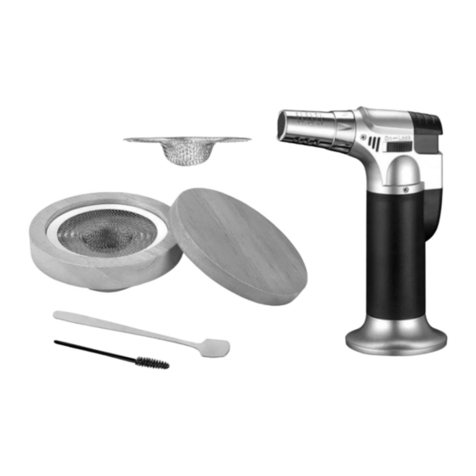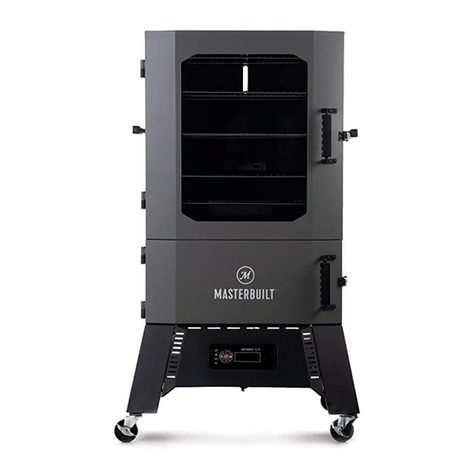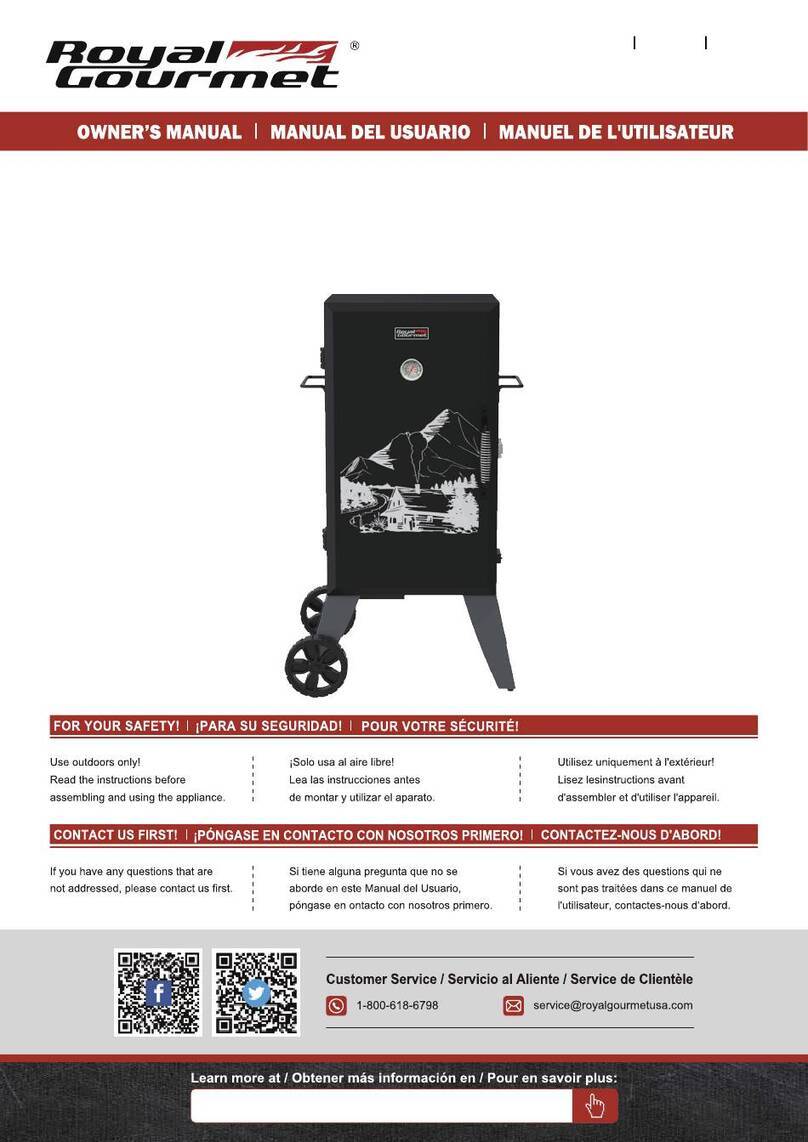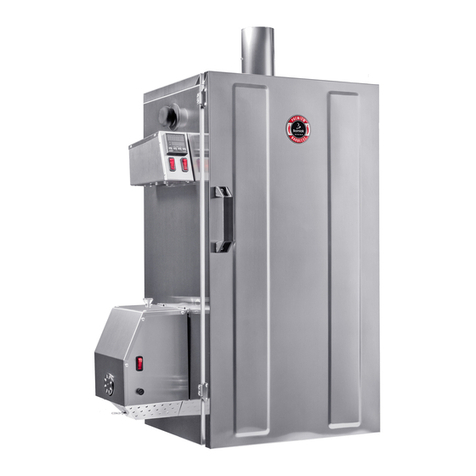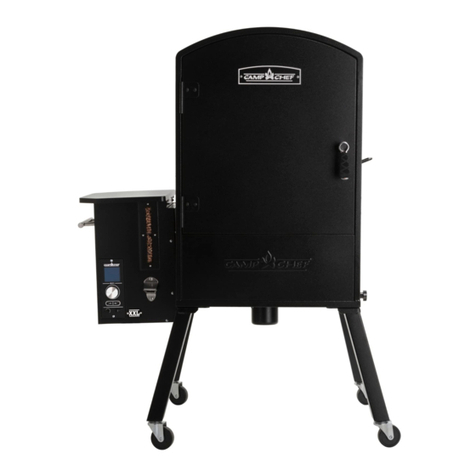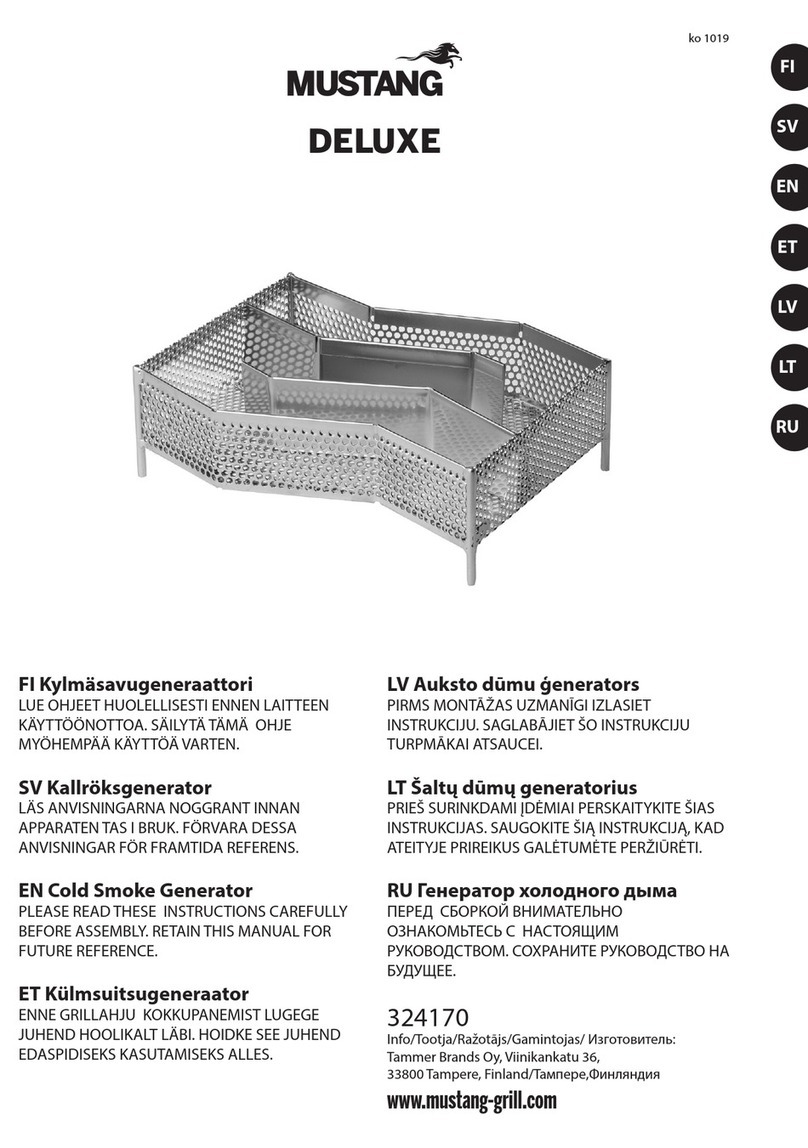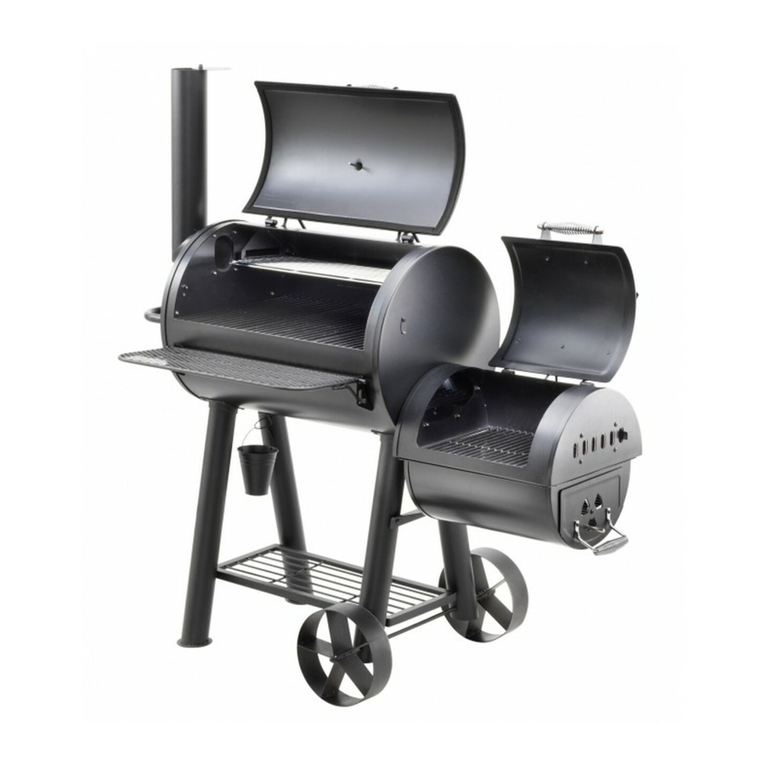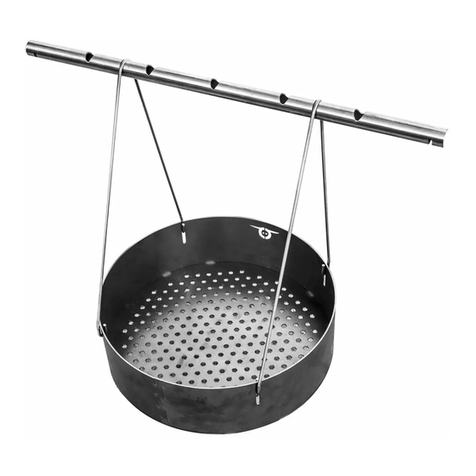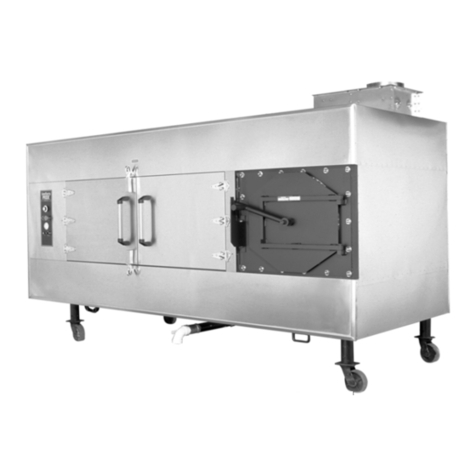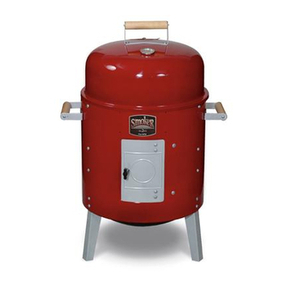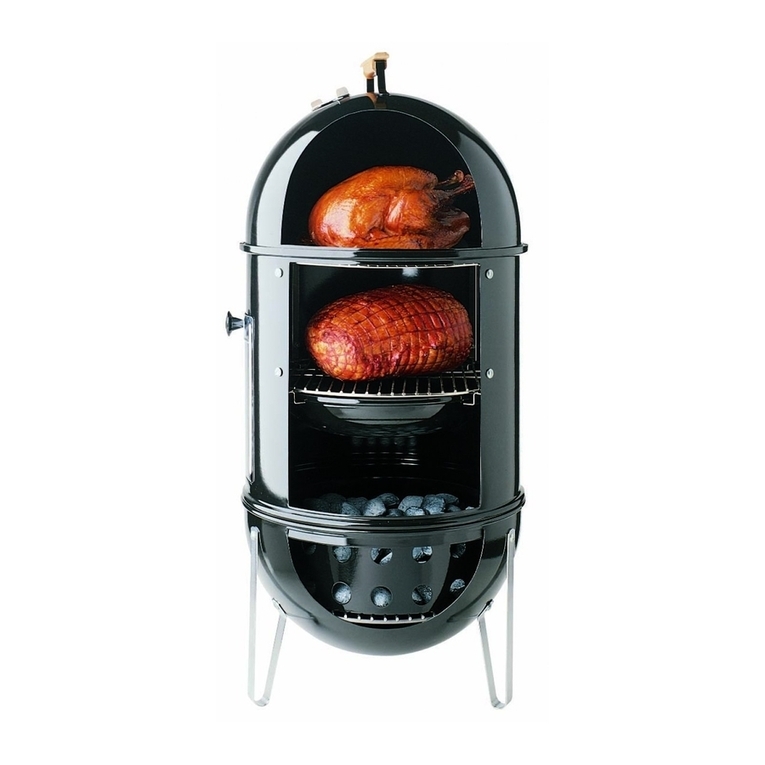SmokinTex 1500 Pro Series User manual

Pro Series Model 1500
Operating Manual

SmokinTex®
Published by SmokinTex,LLC
P.O. Box 2502453
Plano, Texas 75025
Copyright 2008
SmokinTex, LLC
Customer Service
888-922-1511
Fax 214-291-5932
Website: www.smokintex.com
©2008 SmokinTex,LLC
All rights reserved. This book or any part thereof may not be reproduced in any form
without the written permission from SmokinTex,LLC Plano, Texas.

SmokinTex® Pro Series Model 1500 C
SmokinTex introduces the Pro Series 1500
A large electric ( all stainless) smoker at an affordable price.
The Pro Series 1500 uses a dual 700 watt heating element system that gives you the flexibility of using the full
1400 watts or just 700 watts, depending on the load.
With the optional “Deflector Plate” you can direct the drippings onto or away from the wood boxes to reduce the
amount of moisture in the smoker. It’s ideal for doing jerky, summer sausage, and other foods you might prefer
a little dryer.
●Easy to use. Put in wood and food, shut the door, and set the temperature
●No attention needed while smoking/cooking
●Thermostat for even temperature control
●Low, slow, and even temperature is gentle to food
●Smokes beef, pork, poultry, fish, seafood, lamb, sausage, game, vegetables, etc. Makes great jerky!
●Cold smoke with optional cold smoke plate (Great for cheese, pasta, Salmon, etc.)
Specifications
Capacity:
80 lbs Heavy Cuts Per Load
Ribs 42 lb per load
Cabinet Materials:
All stainless steel, inside and out.
Electrical:
2-700 watt heating elements. 1400 watts, 15 amp
120v, single phase
Shelves:
There are 8 shelf positions. The smoker comes with 4 shelves,
3- 18” x 18” heavy duty stainless steel shelves and 1 sea food grill
Outside Dimensions:
21” x 23” x 41” high
Weight:
149 lb boxed
Wheels:
Included

SmokinTex®
Dear SmokinTex Customer:
This manual has been compiled especially for SmokinTex Pro-Series 1500 users. Your SmokinTex
smoker will produce great barbecue and smoked foods. Use this manual to familiarize yourself with
your smoker and its operation. SmokinTex, LLC. assumes no responsibility for results of care-
less and dangerous operation of SmokinTex smokers or other products.
All warranties are null & void if the practices described in this Operator’s Manual are not followed:
Read the following instructions before operating your smoker. The smoker isn’t a complicated appli-
ance, like any oven or smoker, the three ingredients required for success are:
1. Know the appliance (read this manual).
2. Only smoke fresh, quality food products (don’t buy outdated meat).
3. Follow the time and temperatures of the recipe..
Important Safeguards
To avoid electrical shock, do not immerse cord, plugs, or any part of unit in water or other liquid.
Do not leave hot oven unattended with door open.
Unplug when not in use and before cleaning. To disconnect, turn any controls to "OFF". Remove
plug from outlet. Allow to cool before putting on or taking off parts.
Do not expose to rain or sprinkler system.
Extreme caution must be used when moving your smoker while using due to hot grease and food.
CAUTION - to ensure continued protection against risk of electric shock, connect to properly
grounded outlets only.
CAUTION - to reduce the risk of electric shock, keep extension cord connection dry and off the
ground.
Store smoker indoors unplugged when not in use – out of reach of children.
Service should be performed by an authorized service representative only.

SETTING UP
Check the contents of your smoker. You should have 2 side racks, 6 grills, 2 wood boxes 4 wheels,
a grease pan, starter wood, and instructions.
Choose a Location
Choose a dry, sheltered, well-ventilated location. Do not expose the smoker to rain or snow. You
can purchase a cover for your Smoker by calling SmokinTex at (888) 922-1511 or on our wbsite.
Electrical Power Connections
Your Pro-Series Smoker has a dual 700 watt heating system which uses 120V AC power. Connect
the smoker to the power supply by plugging the power cord into a standard, 3-prong, 120V recepta-
cle that is protected by a breaker or fuse rated at 15-20 amperes. A long or light-duty extension cord
will reduce the efficiency of the heating element.
HOW TO USE YOUR PRO-SERIES SMOKER
The interior of your smoker needs to be seasoned prior to smoking your first load.
Remove all packaging materials from inside the smoker, including the shelves and side racks.
(Remove the cardboard protector around the thermostat probe)
Place 8 ounces of wood in the wood box on the left side, and close and latch the smoker door
(below shows a wood box with 8 ounces of hickory).
Never place more than 8 ounces of wood in the smoker. Too
much wood will cause the food to have a bitter taste.
DO NOT use the smoker without the wood boxes in the
proper position. The wood box lids must be closed com-
pletely.
Set temperature control knob to 215°F. with only the 700 watt
element on. Let the smoker smoke, empty, for a minimum of 4 hours. Do not open the door during
this 4 hours.
Use any hardwood in your smoker. The popular woods for smoking are hickory, apple, cherry, mes-
quite, pecan, alder, and maple. Most of these are available from SmokinTex. If you purchase local
wood at the supermarket, be sure the wood box lid closes and don't use more than 8 ounces. There is
no need to soak the wood. Use only dry wood. If you are smoking meat and want the smoke ring
effect add a few pieces of charcoal to the other wood box. The nitrates from the charcoal will pro-
duce the red ring. For added flavor use herbs and spices in the 2nd wood box .

If using indoors place under a vent a hood. There is a lot of smoke the first few hours of
smoke/cooking.
DO NOT leave the smoker uncovered during inclement weather. The smoker should be
covered and unplugged when not in use. Store inside
Operating
There is 1 switch . Center Off. Up Both Heating Elements On. Down One Heating Element
On 2 (left side). There are 2 lights. 1. Power on light. 2 Heating Element on light. The
power on light tells you there is power to the smoker. The heating element on switch tells
you there is power to the heating element this light will go on and off during the smok-
ing/cooking cycle as the thermostat turns on and off the power to the heating element or ele-
ments depending if you are using 1 or both elements.
Controls
Center Off
Switch up Both Elements
1400 Watts
Switch Down
One Element On
700 Watts
Top Light on
AC Power On
Bottom Light
One or Both Elements Heating

Line the bottom of the smoker with foil and punch a hole in the foil through the drain hole (always
be sure the drippings can drain out). A clogged drain could cause grease to accumulate on the
smoker floor, which could cause a fire.
Place the pan provided beneath the drain hole located on the smoker floor. This pan will catch the
meat drippings.
Cover the lid of the wood boxes with foil for easy cleaning. Discard the foil after each cooking and
replace with fresh foil.
Place the properly loaded wood boxes in the smoker. Again, never cook in the smoker without
the wood boxes in position even if you are not using wood. Your smoker is an excellent slow-
cooking and/ or holding oven without wood!
The cooking capacity of your smoker is approximately 80 pounds, depending on the type of meat
you’re smoking. Do not overload your smoker. Keep meat 1/2" from the back and sides of the oven
walls. When the smoker is loaded, close and lock the door. Select 700 or 1400 watts. Turn the tem-
perature control knob to the desired temperature. Heat up will take from 20 to 60 minutes, depend-
ing on the load and the starting temperature of the food you’re cooking.
Do not preheat the smoker. As long as you use the time and temperature recommended in any
recipe you can use that recipe, but not over 250°F.
If a recipe calls for a higher temperature, increase the time. It is a good idea to use a temperature
probe to measure the internal temperature of the product you’re cooking the first time. Temperature
probes are available from SmokinTex.
Never leave the smoker unattended with the door open and the smoker on. When closing down, al-
ways unplug your smoker. Be careful when emptying the wood boxes, they could still be very hot.
Also be careful with the ashes, they could still be very hot and cause a fire. It is a good idea
to remove the wood box from the oven and douse the contents with water. NEVER put the hot ashes
in your trash can.

Your SmokinTex smoker, like your oven, must be kept clean. Loose grease and scale should be re-
moved regularly to prevent build-up.
You never want to take the smoker back to a like new state. For best results, leave the seasoning on
the walls of the smoker. You can keep the shelves and side rails clean in your dishwasher or by your
dish washer whichever is the case.
Internal Temperature Chart
(all temperatures in degrees Fahrenheit)
Beef
Rare 120° Medium-rare 130° - 135° Medium –140° - 145°Well done 160° +
Lamb
Rare 135° Medium rare 140°- 145° Medium 160° Well done 165° +
Poultry
All poultry smoke cook to 170°- until juices run clear
Pork
Medium 160° Well done 170°
Which Wood to Use for What?
Alder: The hickory of the West Coast. Alder's delicate sweet flavor enriches all fish, seafood, and
meats.
Apple: Slightly sweet, fruity smoke that's mild enough for chicken or turkey. Great with all pork.
Cherry:
Cherry produces a similar taste to apple - it produces a very mild and fruity flavor. Great with
chicken, turkey, and fish or flavoring ham.
Hickory:
In the southern barbecue belt, a lot of folks think this is the only wood to use. For everything. Most
BBQ places use nothing else. The strong, hearty taste is perfect for brisket, ribs, and pork shoulder.
Also great with any red meat or poultry.
Maple: Mildly smoky and sweet, maple goes well with poultry, ham, and vegetables. Try with bris-
ket.
Mesquite: The wood of Texas, it's great for grilling but not great for smoking. It burns very hot and
can make your food taste bitter. Get your smoker smoking really well, turn it off, and put in a few
steaks. Smoke for 10 minutes, then finish on a hot grill. Great flavor!

Oak: It's the most versatile of the hardwoods, blending well with a wide range of foods. Gives a
great flavor to brisket.
Pecan: Preferred wood by a lot of non-BBQ restaurants.
Pecan burns cooler and offers a subtle richness of character.
Often referred to as a mellow version of hickory.
Most of these woods can be purchased from SmokinTex
Recipes
Many of SmokinTex's recipes are from Texas Bar B Que. Texas Bar B Que is located in the heart of
downtown Dallas, and is one of two restaurants SmokinTex folks owned and operated in Dallas dur-
ing the 90's. In fact, we may be the only smoker company folks who have owned and operated a
BBQ restaurant. If you don't find the recipe you are looking for here, use your favorite search en-
gine to find the smoked recipe you want. Don't forget, just use the time and temperature recom-
mended by the recipe, not exceeding 250° F.
As you use your Pro-Series Smoker you will come up with recipes you will want to share. Send
them to us and we will include them on our web site.
What Is Brisket?
Brisket is a beef cut taken from the breast section beneath the first five ribs, behind the fore shank.
Fresh brisket is an inexpensive boneless cut that requires long, slow cooking to break down the col-
lagen in the connective muscle tissues to achieve tenderness. In Texas, the whole brisket is known as
"Texas BBQ." In other parts of the country, the long piece is cut in half for marketing. You'll find it
sold as a flat cut or a point cut. The flat cut is leaner, but the point cut has more flavor due to a bit of
extra fat (called the deckle). Where BBQ isn't a big thing, like the North East, they use brisket for
things like corned beef and pastrami.
When picking out a brisket, you will want to choose a "Packer Trimmed Beef Brisket." Your
butcher will know. Pick one between 10 & 12 pounds. The fat protects and flavors the meat during
the long slow smoking /cooking process. It also prevents the meat from drying out while the tender-
izing process of breaking down the collagen in the connective muscle tissues inside is taking place.
An 11 pound brisket will net you approximately 6-7 pounds of useable meat. If you’re planning a
BBQ or dinner party, plan on using 1/3 lb. of smoked brisket per person. That is if you’re only serv-
ing brisket. If you’re also serving, say ribs and/or sausage, you would cut back to 1/4 lb of brisket
per person.

Now it’s smoking time. Load your wood box with 3 pieces of your favorite hardwood. If you
want a smoke ring on your brisket, add a few lumps of charcoal to your wood box. The nitrates in the
charcoal will give you the ring. Now you’re going to say, "They don't put charcoal in an offset BBQ
pit." You’re right, except after the first few hours of smoking in a pit, the wood becomes charcoal and
thus the smoke ring.
Now that you have smoke-cooked the briskets for 12 hours at 200º using no more than 8 ounces of
your favorite hardwood not soaked in water, it's
time to clean and serve or freeze.
A good test to see if it's done is to press your finger
into the fattiest part of the meat. If it is soft and
your finger doesn't have a problem penetrating, it's
ready! After the brisket has cooled down a little,
it's time to clean it.
In Texas most of the BBQ joints clean the brisket
of all the fat. The brisket is in two pieces separated
by a layer of fat. Lay the meat down fat side up.
Position your index finger on the flat part of the
brisket, now move your finger under the fat layer
and towards the back of the brisket. You will be
able to feel where the two pieces are joined and in fact you will be able to separate the two with your
hand part of the way. Then you will need a good knife to finish the job. If you look along the side of
the brisket, you will see where the two are joined. After the deckle is separated from the flat part,
clean both of fat by pulling it off with the knife blade. ( both sides of the deckle)
After they’re cleaned, put them back together the same way they came off and wrap in film or vac-
uum-pack. Now you’re ready to serve or freeze. Keep warm, 150°F, if you’re going to serve it.

Smoked Rib Tips
Cut off chine bone. Trim excess fat. Season with Tony Chachere’s “More Spice.”
Smoke-cook for 2 hours at 225°F using 2 ounces of hickory.
Smoked Baked Potatoes
Rub potatoes with olive oil, smoke at 250°F for 3 to 3
1/2 hours, or until tender.
Leftover smoked baked potatoes, peeled and cubed, are
great for: hash browns,
potato salad, mashed potatoes, potato soups, & chow-
ders.
Try different woods. Hickory is great! So is cherry and
apple. You will love these potatoes.
A-H’s Twice- Cooked Potatoes:
The potatoes above were smoked with hickory, then all
the pulp was removed and mashed with milk, butter, sour cream, and one egg. Seasoning added was:
a pinch of white pepper, a pinch of nutmeg, and fresh ground pepper and salt to taste. Top with bacon
crumbles.
You can hold this in the refrigerator and reheat in the oven later at 350°F for 40 minutes.
This recipe is great for making in the morning and serving to company in the evening.
Smoked Pork Ribs with Honey Marinade
1 clove garlic
1/2 cup fresh orange juice (about 2 large oranges)
5 tbs. honey
2 1/2 tbs. brown sugar
1/2 tbs. soy sauce
2 pounds pork spare ribs
Peel and crush garlic and mix with orange juice,
honey, sugar, and soy sauce in a shallow casserole dish
or plastic freezer bag. Place spare ribs in sauce, cover, and leave to marinate overnight, turning often.
Smoke at 225°F for 3 - 4 hours with 4 ounces apple, cherry, or maple wood.

Baby Back Ribs
Ribs are very sacred to the average BBQ enthusiast. Like BBQ sauce, everyone has their own best rec-
ipe, and no one wants to hear of a different way of doing them. That is what makes BBQ so great. Some
boil them first, some don’t. Some use a wet sauce, some use a dry rub only. (Go to Yahoo and type in
“rib rub,” and you will get over 17,000 web site pages with rib rubs.) In some parts of the country, ribs
are BBQ. This is true in Kansas City. So after you smoke your first several batches of ribs, come up with
your own way of doing them and let us know. Below we vacuum- packed the ribs with Tony Chachere’s
Butter & Jalapeno Marinade and held overnight. Great! Select good quality meat. Get to know your
butcher.
Remove the silverskin.
Rub with your favorite rib rub. If you go online and do a search for a rib rub recipe you will get over
51000 hits.

Smoked Pork Sandwich Eastern North Carolina Style with Tidewater
Coleslaw
This is a fantastic BBQ, pulled-pork sandwich. In the South Eastern States this is to the BBQer what
brisket is to Texans, what tri-tip is to people on the West Coast, and what a luau is to Hawaiians!
The coleslaw is put directly on top of the pork, which is put directly on the bun. Add a little sauce,
and you have about the best eating there is!
2 (4 to 5-pound) boneless pork butts
Rub
2 tbs. salt
2 tbs. sugar
2 tbs. brown sugar
2 tbs. cumin
2 tbs. chili power
2 tbs. cracked black pepper
1 tbs. cayenne pepper
1/4 cup paprika
In a bowl, combine the rub spices. Mix
well and rub the butts all over with the
rub
Smoke cook at 225°F for 5 hours using 8 ounces of apple or hickory wood. Wrap in foil and finish in
your oven at 300°F for 2 1/2 hours. When it falls apart, it’s ready. Pull or chop pork, mixing in the
vinegar sauce. Stack on a bun and top with the coleslaw. Add your favorite mustard or BBQ sauce, or
just a little Tabasco.
Vinegar Sauce
1 Cup white vinegar
1 Cup cider vinegar
1 Tablespoon crushed red pepper
Dash of hot sauce
Tidewater Coleslaw
1 1/2 cups mayonnaise
1/2 cup white vinegar
1/3 cup sugar
1 tbs. celery seed
Salt and pepper to taste
Small head green cabbage, finely shredded
2 carrots, grated.
Blend first five ingredients well. Mix cabbage and carrots with slaw dressing
We have found that the pre-cut bags of coleslaw are great as long as you can get the fine grade. You
want the cabbage and carrots finely-shredded.
The pork freezes well in plastic freezer bags and makes a great quick sandwich. Just heat in the mi-
crowave or in boiling water if you’re using a food saver bag.

.Turkey How-to:
Smoking is a fantastic method for cooking a turkey. Turkey is extremely mild, and smoking gives it a
rich, complex flavor in addition to producing moist, tender meat. Oven-roasted turkey often runs into
the problem of being dry and tough. This is caused by overcooking, which is extremely easy to do
when you're roasting a turkey. However, it's almost impossible to overcook anything in your Smokin-
Tex smoker because the temperature remains low and the cooking is slow.
Which Wood to Use
The wood provides the smoke, and the smoke provides the flavor, so choose your wood with care. You
can use whatever variety of wood you like best. Any kind of fruit wood, such as apple or cherry, com-
plements turkey very well, but hickory, pecan, and maple will be equally enticing. All the woods above
are available through SmokinTex.
How to Pick the Turkey
We recommend that, if you wish to smoke a whole bird, you choose one that weighs no more than
about 18 pounds. Larger birds take too long to heat all the way through since the smoker cooks at the
low temperature of 225°. If you choose a frozen turkey, it should be thoroughly thawed before you be-
gin.
Important Points
Food safety is of primary concern when smoking turkey. Turkey breasts, drumsticks, wings, and whole
turkeys are all suited for smoking, although for safety's sake, stick with whole turkeys that weigh 18
pounds or less.
Thawing from the ExpertsTurkey thawing hints from the National Turkey Federation:Turkeys
can be thawed using one of three methods, but the most fool-proof is in the refrigerator. The key to this
method is to plan ahead and allow approximately 24 hours for every five pounds of bird weight for
thawing in the refrigerator. This method is the safest and will result in the best finished product. Place
the bird, in the original wrapping, on a shallow baking dish in the refrigerator. The following chart pro-
vides good guidelines for thawing times:
If you need to thaw the turkey more quickly, you may thaw the bird in COLD water, in the original
wrapping. The cold water must be changed every 30 minutes. Allow approximately 30 minutes per
pound using this method.
Refrigerator turkey
thawing time (40°F )
Turkey weight Days to allow for thawing turkey
8 to 12 pounds 1 to 2 days
12 to 16 pounds 2 to 3 days
16 to 20 pounds 3 to 4 days
20 to 24 pounds 4 to 5 days

COLD water turkey thawing time
Turkey weight Hours to allow for thawing
8 to 12 pounds 4 to 6 hours
12 to 16 pounds 6 to 8 hours
The third safe method for thawing a turkey is in the microwave. Follow the manufacturer’s direc-
tions, and roast the turkey immediately after thawing. Make sure that you have removed all the gib-
lets and gizzards from the turkey, as well as the plastic pop-up thermometer.
Bring on the Brine
Brining is not an essential part of smoking a turkey, but most people agree that soaking in a brine
gives their smoked meat maximum flavor and juiciness. Brine is a mixture of water and salt, and
usually sugar or honey as well. Many brine recipes also include a variety of spices. A whole turkey
can take up to 24 hours of brining, so plan ahead! After you remove your turkey from the brine and
are ready to smoke it, rinse it thoroughly in cool water to remove excess salt, and then drain it and
pat the bird dry with paper towels.
Rub It with Spice (You don’t rub it. Sprinkle it on)
For evenly browned skin, rub the entire bird, in and out, with oil or butter. To add extra flavor, you
can also massage the turkey with a dry rub right before smoking, Keep in mind that, if you have
brined the turkey, you should not use any salt in the dry seasoning mixture, or your turkey will taste
far too salty to eat! Unfortunately, stuffing a smoked turkey is not recommended. If you've got
your heart set on stuffing, you can make it separately in the oven.
You Can't Rush a Good Thing
Although smoking a turkey is pretty easy, it takes time. With your smoker running at 225° F, the
turkey will need about 50 minutes per pound to cook to perfection. So, a 12-pound bird needs at
least 10 hours, and even more if the smoker is at a lower temperature. ]
Give yourself plenty of time!
When the smoker is cleaned and ready with
foil on the floor, (don’t forget to put your fin-
ger through the drain hole) place the oiled and
seasoned turkey directly on the center rack
breast-side up. Close the smoker door, and set
your temperature. Avoid opening the smoker
too often because you will lose heat and in-
crease the cooking time. Using the "50 min-
utes per pound" rule, calculate how long the
turkey will take, and start checking the temperature at the end of this time. Insert the meat ther-
mometer deep into the thigh, being careful not to touch the bone or joints. When the thermometer
reads 180°F , pull it out of the smoker, let it rest 15 minutes, and then serve.
Note: Your customers may think the turkey is raw if they've never encountered smoked turkey be-
fore. The white meat has a pinkish hue although it is cooked all the way through.
This manual suits for next models
1
Table of contents
Other SmokinTex Smoker manuals
